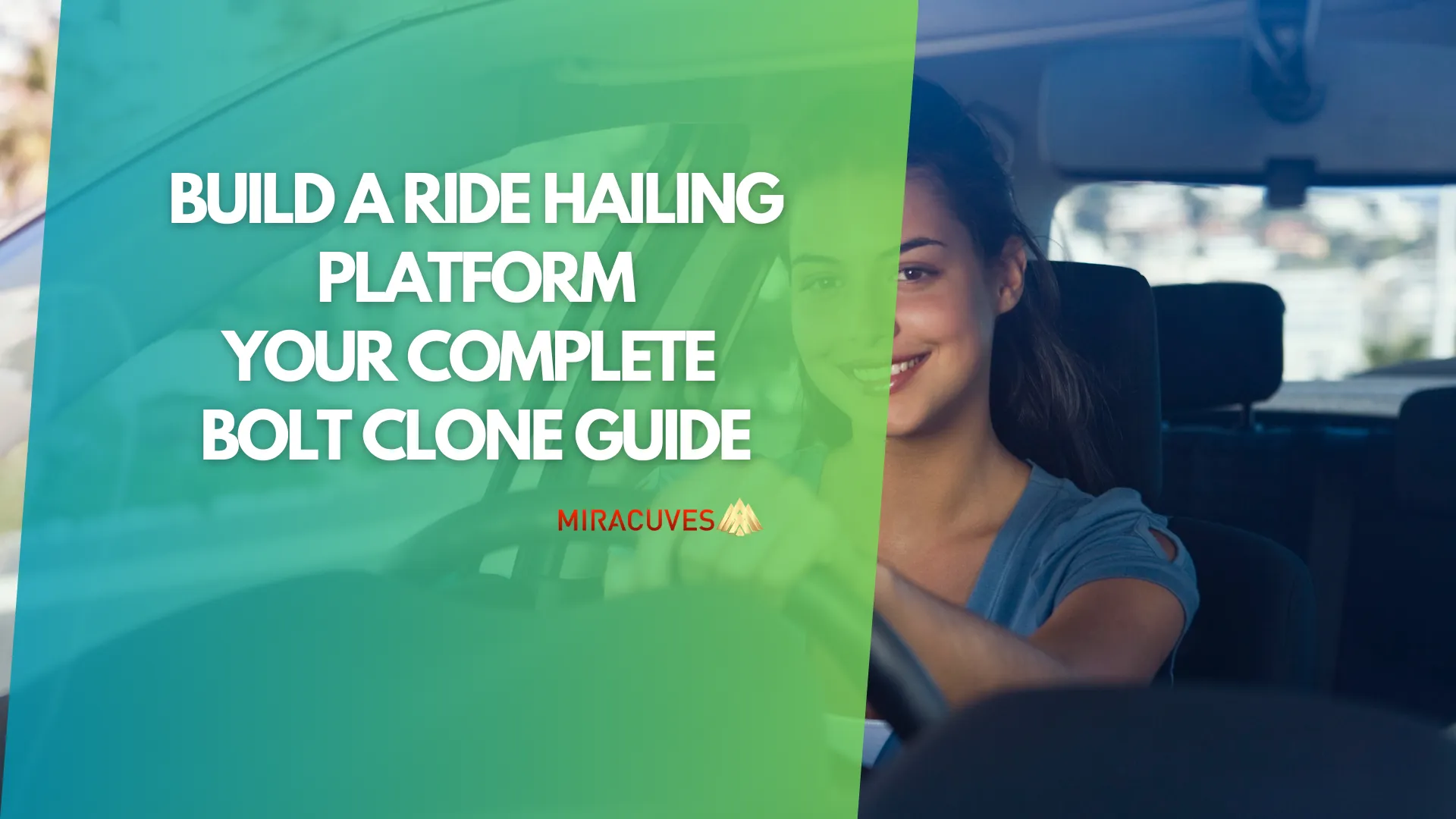The world of transportation has evolved rapidly with the rise of ride-hailing platforms like Bolt, which offer fast, affordable, and convenient urban mobility solutions. Bolt has grown into a major player by providing multiple services, from carpooling and on-demand rides to scooter rentals. The success of platforms like Bolt highlights the increasing demand for flexible and efficient transportation, creating an exciting opportunity for new entrepreneurs to build their own ride-hailing apps.
Criando um Bolt clone involves more than just replicating its features. It requires innovation, localization, and smart monetization strategies to meet evolving customer expectations. Whether you aim to target a specific city or expand across multiple regions, developing a plataforma de transporte can unlock several revenue streams, including commissions, in-app ads, and subscription models.
This guide provides you with a step-by-step roadmap to build a ride-hailing app, from understanding the core features of the MVP to scaling your platform for future growth. With Soluções Miracuves, you can skip the long development timelines by leveraging ready-made templates to launch your app 30 vezes mais rápido and at just 10% do custo global.
Whether you’re a startup, an entrepreneur, or an established business exploring the mobility sector, this guide will walk you through the entire process, ensuring you create a robust, scalable, and user-friendly platform.
What the App Is and What It Does
UM ride-hailing platform like Bolt offers more than just convenient transportation—it creates an integrated mobility ecosystem that serves the needs of both riders and drivers. These apps allow users to book rides on-demand, schedule trips in advance, ou share rides to reduce costs. But the beauty of platforms like Bolt lies in their ability to provide multiple services within a single app, making them attractive to both urban commuters and drivers seeking flexible work opportunities.
Core Functions of a Bolt Clone App
- On-Demand Rides and Scheduling
- Users can request instant rides or schedule them for later, ensuring flexible and reliable transportation.
- Carpooling and Shared Rides
- The app promotes shared rides to lower fares, reduce traffic, and promote eco-friendly travel.
- Driver-Friendly Features
- Drivers get access to tools such as route optimization, earnings reports, e availability toggles to make work more manageable.
- Cashless Payments and Digital Wallets
- Users can pay with cards, digital wallets, or cash, creating a seamless experience.
- Rating and Feedback System
- Riders and drivers can rate each other, ensuring service quality and fostering trust within the platform.
UM aplicativo de transporte also serves as a bridge between drivers and passengers, offering rastreamento em tempo real, transparent pricing, and fast access to transportation. With urban mobility on the rise, these apps have become essential for commuters, providing fast, reliable, and safe transportation options at the tap of a button.
Leia também:- How to Build an Uber Clone App: A Complete Guide
| Recurso | Bolt | Your Ride-Hailing App |
|---|---|---|
| On-Demand Rides | Sim | Sim |
| Ride Scheduling | Sim | Sim |
| Carpooling | Sim | Optional |
| Cashless Payments | Sim | Sim |
| Driver Dashboard | Sim | Customizable |
| Rating System | Sim | Sim |
Por que criar este aplicativo?
O ride-hailing industry is booming, and there has never been a better time to launch your own Bolt clone app. With urbanization increasing and people preferring on-demand transportation over traditional taxis, the demand for convenient, cashless, and eco-friendly mobility solutions is rising. Here are a few compelling reasons why building a plataforma de transporte can be a highly profitable business move:
1. Growing Demand for On-Demand Services
- People in urban areas need quick and reliable transport, especially during peak hours. Ride-hailing platforms offer flexibility with instant bookings and scheduled rides, catering to this demand.
2. Multiple Revenue Streams
- UM aplicativo de transporte provides several income sources, including ride commissions, driver subscriptions, in-app advertisements, and partnerships with local businesses.
3. Rising Preference for Eco-Friendly Travel
- Apps that offer shared rides and electric vehicle options align with consumer preferences for environmentally sustainable transport, giving your platform an edge.
4. Capturing Untapped Markets
- There are many regions where ride-hailing services are still in their infancy, providing a great opportunity to enter new markets and establish early dominance.
5. Lower Operational Costs with a Digital-First Model
- Unlike traditional taxis, ride-hailing apps run on a digital-first model with lower overhead costs, as you don’t need to manage physical fleets—just a smooth platform that connects drivers and riders.
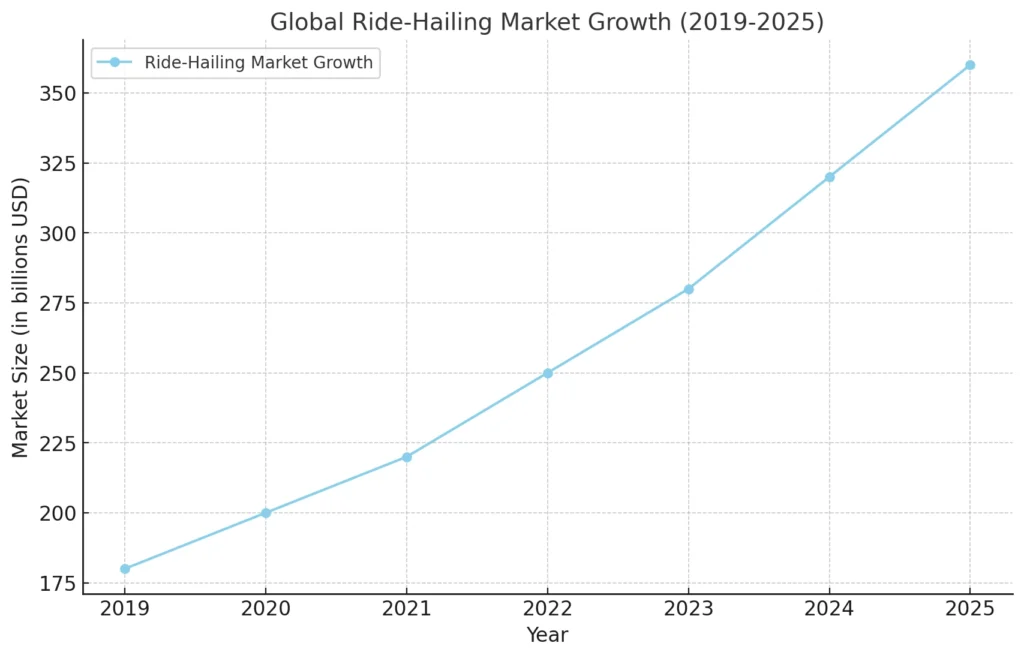
How to Differentiate from Competitors
With numerous ride-hailing apps available, it’s essential to find ways to stand out and build a loyal user base. Differentiating your platform isn’t just about replicating features—it’s about creating a unique experience that resonates with your audience. Below are effective strategies to set your Bolt clone apart from other ride-hailing platforms.
1. Offer Eco-Friendly Transportation
- Introduce electric vehicles (EVs) or hybrid cars into your fleet to attract environmentally conscious users. You can also incentivize drivers to switch to eco-friendly options.
2. Create Personalized Experiences with AI
- Implement Recomendações com tecnologia de IA to offer personalized ride suggestions based on user behavior and preferences. For instance, the app can suggest favorite destinations during regular times.
3. Introduce Loyalty Programs
- Create a points-based loyalty program where users earn discounts or rewards for frequent rides and referrals. Loyalty programs can enhance user retention and drive more app engagement.
4. Localized and Specialized Services
- Oferecer localized services such as bike taxis in congested cities or carpooling options for areas with high commuter traffic. Tailoring your app to local needs makes it more appealing.
5. Enhanced Safety Features
- Provide safety tools like real-time location sharing, emergency SOS buttons, e background checks for drivers. Safety is a significant factor for passengers and can help your app build trust.
While developing your Bolt clone, analyzing the strengths and weaknesses of existing ride-hailing platforms can help you identify gaps and opportunities. Platforms like InDrive and Uber offer unique features tailored to their markets, which can inspire enhancements in your app. For example, focusing on user-driven pricing models or real-time ride negotiations can provide a distinct edge. InDrive vs Uber Clone comparison highlights these competitive strategies, offering valuable insights to refine your app’s unique selling points.
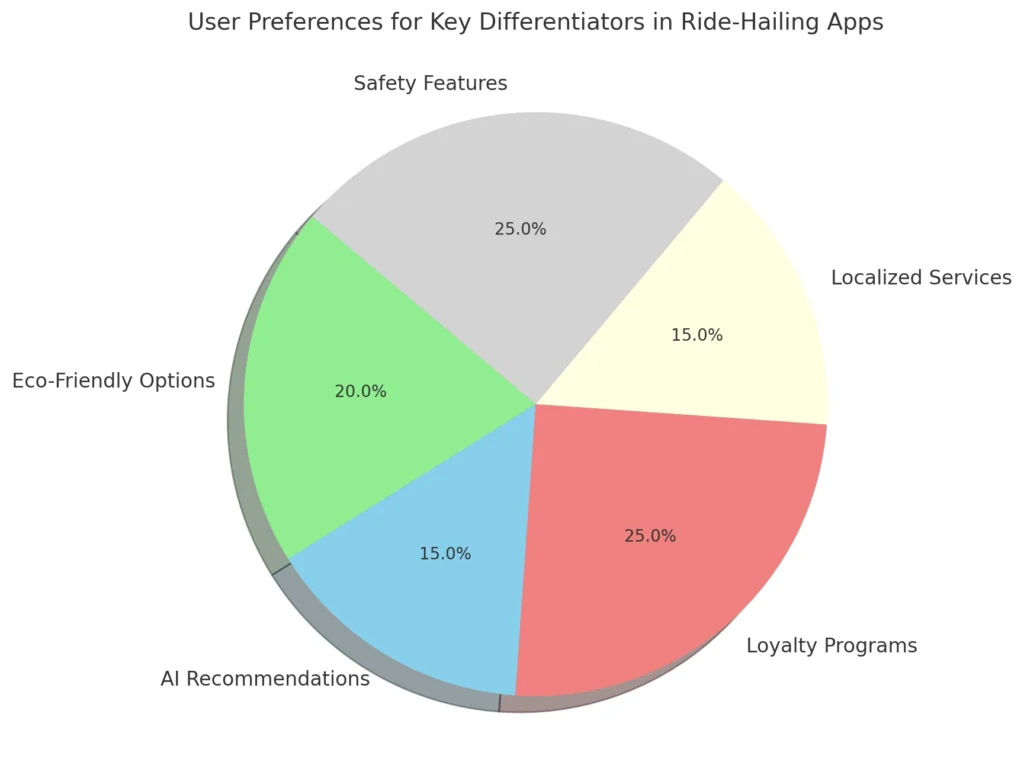
Tamanho do mercado e crescimento da indústria
O ride-hailing industry continues to show impressive growth, driven by rising urbanization, demand for convenience, and the global shift towards mobility-as-a-service (MaaS). With evolving customer preferences and governments encouraging the use of shared and eco-friendly rides, the industry is poised for even greater expansion in the coming years.
Global Market Insights
- Tamanho atual do mercado
- In 2023, the global ride-hailing industry reached approximately $280 billion in market value, with projections indicating it could hit $360 billion by 2025.
- Taxa de crescimento anual
- The sector is expected to grow at a 10-12% CAGR (Compound Annual Growth Rate) over the next decade, fueled by increased adoption of on-demand transportation and the integration of carpooling and electric vehicles.
- Emerging Markets Driving Growth
- Countries in Southeast Asia, Africa, and Latin America represent untapped markets with significant potential for ride-hailing platforms, as smartphones and internet access become more widespread.
- Post-Pandemic Recovery Trends
- The industry has rebounded quickly from the pandemic, with contactless payments e carpooling options gaining popularity as safety and affordability remain key concerns.
As consumer habits evolve, industries such as online shopping and ride-hailing are witnessing rapid growth. According to insights from Estatista, the demand for convenient, on-demand services is expected to surge, creating new opportunities for businesses entering this space.
| Região | 2020 Market Size (in billions) | 2023 Market Size (in billions) | 2025 Projected Market Size (in billions) |
|---|---|---|---|
| América do Norte | 75 | 85 | 100 |
| Europa | 50 | 60 | 75 |
| Ásia-Pacífico | 100 | 130 | 180 |
| América latina | 20 | 30 | 40 |
| Middle East & Africa | 15 | 20 | 30 |
Principais recursos do aplicativo
Para construir um sucesso plataforma de transporte like Bolt, your app must provide a seamless user experience and offer essential tools for drivers, passengers, and admins. Key features are what make the difference between an average app and one that retains users, attracts drivers, and scales effortlessly. Here’s a look at the features you need to implement in your Bolt clone app.
1. Essential Features for Passengers
- Real-Time Ride Tracking: Allow passengers to track drivers on a live map, ensuring transparency and peace of mind.
- Várias opções de pagamento: Enable payments through credit/debit cards, digital wallets, or cash to offer flexibility.
- Bate-papo no aplicativo: Seamlessly connect passengers and drivers for better communication during rides.
2. Essential Features for Drivers
- Route Optimization and Navigation: Provide built-in GPS and route optimization to help drivers reduce travel time and fuel consumption.
- Painel de ganhos: Allow drivers to track their daily and monthly earnings and receive payout notifications.
- Availability Toggle: Drivers can easily indicate their availability, ensuring they can manage work hours efficiently.
3. Admin Panel Features
- Ride and User Management: Track ongoing rides, monitor user behavior, and manage disputes in real time.
- Driver Performance Monitoring: Access detailed insights into driver ratings, feedback, and performance to maintain service quality.
- Promotions and Discounts: Set up offers, coupons, and loyalty programs to encourage repeat usage.
Leia também:- Build a Ride-Hailing App Like Didi
| Recurso | Aplicativo de Passageiros | Aplicativo do motorista | Painel de Administração |
|---|---|---|---|
| Rastreamento em tempo real | Sim | Sim | Monitor Rides |
| Várias opções de pagamento | Sim | View Payments | Manage Transactions |
| Route Optimization | Não | Sim | Monitor Routes |
| Painel de ganhos | Não | Sim | View Driver Reports |
| Availability Toggle | Não | Sim | Track Driver Availability |
| Promotions and Discounts | Access Offers | Não | Create and Manage Offers |
MVP (Minimum Viable Product) and Development Approach
Lançando um Produto Mínimo Viável (MVP) allows you to enter the market quickly while minimizing risks. An MVP focuses on the principais características essential for user engagement, helping you test the market, gather feedback, and improve your product before scaling. Below is a breakdown of the key components for your Bolt clone’s MVP and the best development approach to ensure a smooth and efficient launch.
Core Features to Include in the MVP
- User Registration and Login
- Simple registration via email, phone number, or social media ensures a quick onboarding process.
- Real-Time Ride Booking
- Users can book rides instantly, with live driver tracking and estimated time of arrival (ETA).
- Integração de pagamento
- Include multiple payment methods (cards, wallets, or cash) to provide users with convenience and flexibility.
- Driver Management Tools
- Basic tools for drivers, including availability toggles, trip management, and route optimization.
- Rating and Feedback System
- Collect feedback from passengers and drivers to improve service quality and boost trust within the platform.
Benefits of an MVP Approach
- Tempo de colocação no mercado mais rápido: Launching with essential features allows you to enter the market quickly.
- Custos de desenvolvimento mais baixos: By focusing only on core functionalities, you reduce initial expenses.
- User Feedback for Improvement: Early user feedback helps identify pain points and areas for growth.
- Test Market Fit: Validate your app concept before committing to a full-featured product.
Using Miracuves Solutions for Faster MVP Delivery
Com Soluções Miracuves, you can launch your MVP in just one day using their ready-made app templates. This is a significant advantage compared to traditional development, which could take months. The ability to start collecting feedback right away ensures you stay ahead of competitors while continuously enhancing your app.
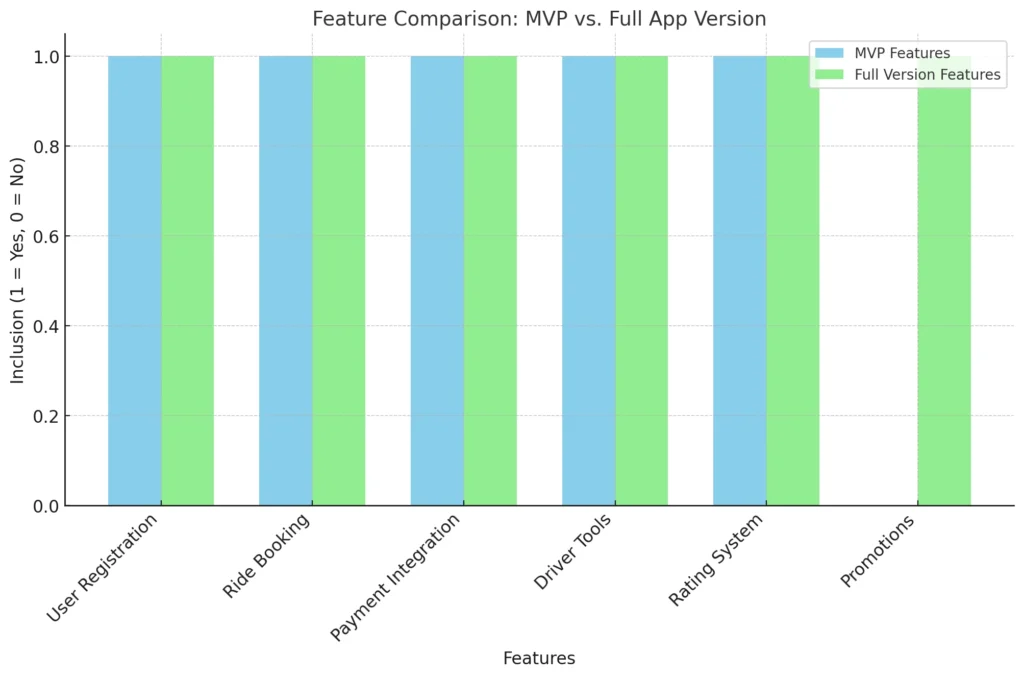
Requisitos técnicos
Construindo um plataforma de transporte like Bolt requires a solid technical foundation to ensure the app performs seamlessly, scales efficiently, and offers a secure user experience. Choosing the right pilha de tecnologia is crucial for developing a platform that is reliable, responsive, and future-proof. Below are the core technical components your app will need.
1. Frontend Development
- Estruturas: Usar Reagir Nativo ou Flutter to build a cross-platform app that works on both iOS and Android, reducing development time and cost.
- Responsive UI Design: Ensure the design adapts well across devices, including smartphones and tablets.
2. Backend Development
- Node.js ou Django: These frameworks offer high performance and scalability to handle API calls and process real-time ride requests.
- Express.js: Use Express for building lightweight APIs that connect the frontend and backend seamlessly.
3. Database Management
- MySQL or PostgreSQL: Store structured data such as user profiles, ride history, and payment details.
- Firebase: Ideal for real-time updates like live tracking and push notifications.
4. Cloud Hosting and Storage
- AWS, Google Cloud, or Microsoft Azure: Use cloud services to ensure the app is scalable and secure. They also provide tools for load balancing and backup services.
5. Payment Gateway Integration
- Stripe, PayPal, or Razorpay: Integrate multiple payment gateways for smooth in-app payments. Support for digital wallets like Google Pay or Apple Pay will enhance the user experience.
6. Third-Party APIs
- API do Google Maps: Enable location services and real-time tracking for both drivers and passengers.
- Twilio API: Use for SMS notifications and real-time updates to keep users informed.
| Componente | Global Standard Tech Stack | Miracuves Solutions Stack |
|---|---|---|
| Estrutura Frontend | React Native, Flutter | React Native, Flutter |
| Backend Framework | Node.js, Django | Node.js, Express.js |
| Banco de dados | MySQL, PostgreSQL | PostgreSQL, Firebase |
| Hospedagem em Nuvem | AWS, Google Cloud | AWS, Google Cloud |
| Gateways de pagamento | Faixa, PayPal | Faixa, PayPal |
| APIs | Google Maps, Twilio | Google Maps, Twilio |
Design e Interface do Usuário (UI/UX)
Quando se trata de ride-hailing apps, the design and user experience (UX) can make or break your platform’s success. A clean, intuitive, and user-friendly design ensures users can navigate the app with ease, while drivers find it simple to manage rides. Great UI and UX keep users engaged, encourage repeat use, and build trust in your platform.
1. Key UI/UX Principles for Your Bolt Clone
- Minimalistic and Intuitive Layout
- Design a clutter-free home screen with easy access to essential services such as ride booking, trip history, and payments.
- Responsive Design Across Devices
- Ensure the app works seamlessly on smartphones, tablets, and web browsers, giving users and drivers flexibility.
- Quick Access Features
- Usar floating action buttons (FAB) for quick access to key functions like ride booking or payment status.
- Clear Navigation for Drivers
- Provide simple, step-by-step instructions for drivers, including optimized routes, ride notifications, and earnings reports.
- Experiência de usuário personalizada
- Implement light and dark mode themes to enhance accessibility and align with user preferences.
2. Leveraging Miracuves Pre-Built UI Templates
Com Soluções Miracuves, you can skip the lengthy design process by using Ready-made, customizable templates. These templates are optimized for user engagement and can be branded to match your app’s identity. This not only saves time but ensures a professional, modern look from day one.
Leia também:- Building a Lyft Alternative: Complete Guide
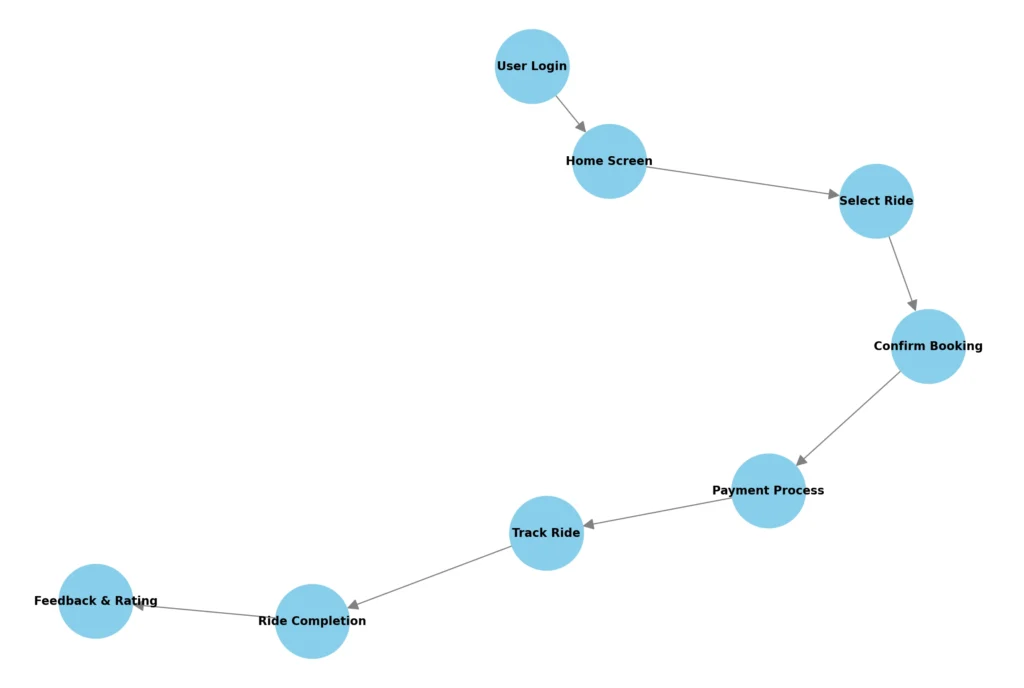
Processo de desenvolvimento
Construindo um plataforma de transporte like Bolt requires a well-structured development process that ensures your app is efficient, scalable, and user-friendly. Each phase, from planning to launch, plays a critical role in ensuring smooth operations and a seamless user experience. Here’s a detailed breakdown of the processo de desenvolvimento to get your app off the ground:
1. Market Research and Requirement Gathering
- Identify your target audience and analyze competitors to find gaps and opportunities.
- Gather the requirements for features, design, and tech stack based on market trends and user needs.
2. Wireframing and Prototyping
- Create wireframes that visualize the app layout and structure.
- Develop an interactive protótipo to get early feedback and refine the user interface.
3. Frontend and Backend Development
- Front-end: Use React Native or Flutter to build a cross-platform app for iOS and Android.
- Back-end: Use Node.js or Django to manage APIs, process data, and ensure smooth communication between the app and server.
4. API Integration and Payment Setup
- Integrar API do Google Maps for real-time tracking and optimized routes.
- Add payment gateways like Stripe or Razorpay for seamless transactions.
5. Testing and Quality Assurance
- Perform both manual and automated testing to ensure the app is bug-free and performs well under heavy loads.
- Conduta teste beta with a select group of users to identify potential issues before the full launch.
6. Deployment and Launch
- Deploy the app to Google Play Store and Apple App Store, ensuring it meets their guidelines.
- Configurar cloud hosting using AWS or Google Cloud to ensure scalability and reliability.
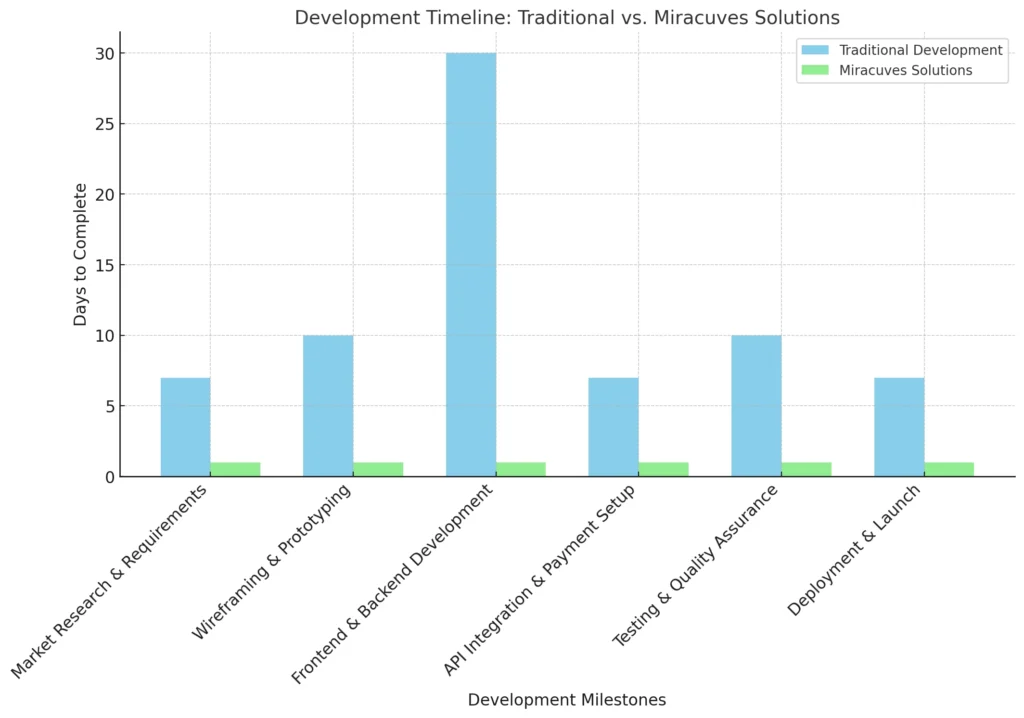
Estimativa de custos e prazo
Understanding the cost and development timeline is essential for planning your ride-hailing app. Developing an app like Bolt requires smart budgeting and careful selection of features to balance quality with affordability. Let’s break down the estimated costs and time required, comparing global development trends with the efficiency provided by Soluções Miracuves.
1. Global Cost Estimates
- Basic Ride-Hailing App: $5,000 to $15,000 for essential features (real-time tracking, payments, ride booking).
- Advanced Multi-Service App: $20,000 to $60,000, including AI recommendations, loyalty programs, and driver analytics.
- Annual Maintenance: 15–20% of the development cost, covering regular updates and bug fixes.
2. Cost with Miracuves Solutions
- Total Cost: Just $2000 for a fully functional ride-hailing app—10% do custo médio global.
- This cost covers pre-built templates, integration-ready solutions, and rapid deployment, enabling you to launch quickly without sacrificing quality.
3. Development Timeframe
- Desenvolvimento Tradicional: 1–2 months for a basic version, or up to 4–6 months for a complex multi-service app.
- Soluções Miracuves: 1 day for a fully operational app, using projetos prontos and pre-integrated APIs.
| Componente | Global Average | Soluções Miracuves |
|---|---|---|
| Custo de desenvolvimento | $5,000 to $60,000 | $500 to $6,000 |
| Tempo de desenvolvimento | 1–6 months | 1 day |
| Annual Maintenance Cost | 15–20% of development cost | 15–20% of development cost |
Estratégias de Monetização
Creating a ride-hailing platform like Bolt opens doors to multiple fluxos de receita beyond ride commissions. To ensure sustainable growth and profitability, you must explore various estratégias de monetização that suit your market and user base. Below are some of the most effective strategies to maximize your platform’s earnings.
1. Modelo baseado em comissão
- Per-Ride Commission: Take a percentage of every ride booked through the app. This is a core revenue stream used by most ride-hailing platforms.
- Dynamic Commission Rates: Implement surge pricing during peak hours to increase revenue when demand is high.
2. Subscription Plans for Drivers
- Driver Subscription Models: Offer subscription plans that provide priority booking and reduced commission fees for drivers.
- Weekly or Monthly Plans: Drivers can choose from flexible payment models based on their needs, ensuring they stay active on the platform.
3. In-App Advertisements
- Promoted Listings: Allow restaurants, stores, or other local businesses to feature their services within the app.
- Sponsored Ads: Display targeted ads that align with users’ interests and journeys.
4. Partner Programs and Affiliate Marketing
- Collaborate with Local Businesses: Offer bundled services, such as ride-and-dine packages, where users receive discounts.
- Marketing de afiliados: Earn commissions by promoting services like travel insurance, financial products, or vehicle rentals.
5. Loyalty Programs and Referral Rewards
- Loyalty Points: Introduce a system where users earn points for every ride, redeemable for discounts on future bookings.
- Programas de referência: Encourage users to invite friends by offering ride credits for each successful referral.
6. Data Monetization
- Analytics and Reports: Sell anonymized data insights to urban planners or businesses interested in transportation trends.
- Recomendações baseadas em IA: Use machine learning to personalize recommendations and cross-sell services within the app.
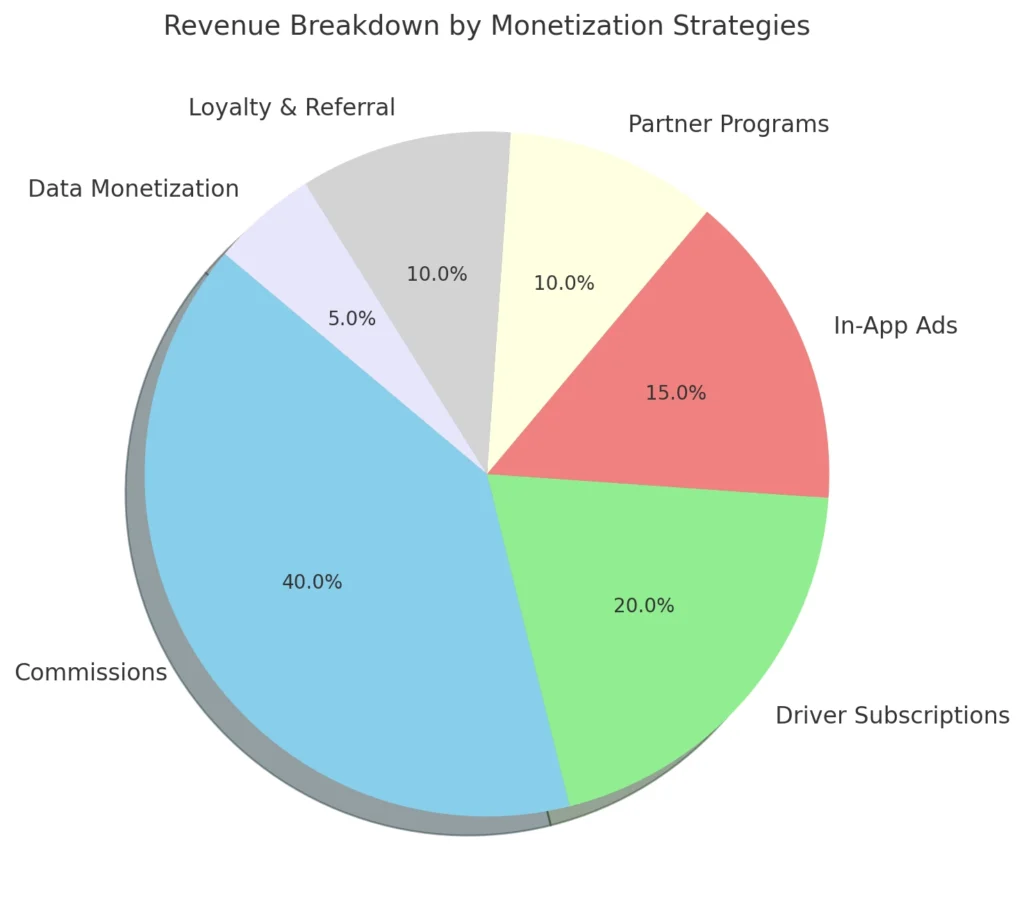
Lançamento e marketing do aplicativo
A successful app launch requires more than just development—it’s about capturing attention, generating excitement, and building a user base from day one. Your launch and marketing strategy will determine how quickly your plataforma de transporte gains traction. Here’s a roadmap to help you plan your pre-launch, launch, and post-launch marketing efforts.
1. Pre-Launch Activities
- Teste Beta: Release your app to a small group of users for testing. Collect feedback, identify bugs, and make necessary improvements before the official launch.
- Build Hype on Social Media: Share sneak peeks, behind-the-scenes content, and launch countdowns to generate excitement. Collaborate with influencers to reach a broader audience.
2. Launch Day Strategy
- Press Releases and Launch Event: Announce your app launch with a press release sent to local media. If possible, host an online or in-person launch event to demonstrate the app’s features.
- Otimização da App Store (ASO): Optimize your app’s listing on Google Play and Apple App Store with relevant keywords, screenshots, and engaging descriptions to attract downloads.
3. Post-Launch Marketing
- Social Media Campaigns: Run targeted ads on platforms like Instagram, Facebook, and Twitter to drive downloads. Create interactive content like quizzes, polls, or contests to engage users.
- Programas de referência: Encourage users to refer friends by offering ride credits or discounts. Word-of-mouth marketing is a powerful way to grow your user base.
- Partnerships with Local Businesses: Collaborate with restaurants, cafes, or retail stores to offer promotional codes and ride discounts that benefit both users and partners.
4. Ongoing User Engagement
- Push Notifications and Email Campaigns: Keep users informed with personalized offers, ride suggestions, and seasonal discounts.
- Continuous Improvements Based on Feedback: Use in-app surveys and reviews to gather feedback, ensuring your app evolves with user expectations.
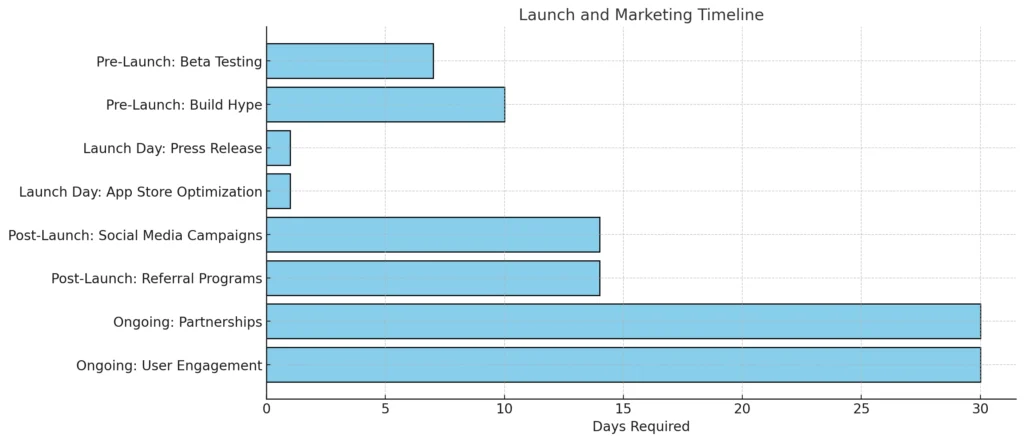
Considerações legais e regulamentares
When launching a plataforma de transporte, it’s essential to navigate the legal and regulatory landscape to ensure your business operates smoothly and legally. Complying with local laws not only avoids fines and shutdowns but also builds trust with drivers, users, and authorities. Below are the key legal aspects to consider.
1. Licensing and Permits
- Transport Permits: Depending on your location, you may need government approval to operate a ride-hailing service. Some cities require specific taxi or private hire vehicle licenses.
- Food Delivery or Parcel Permits: If your platform offers delivery services, compliance with local delivery regulations is essential.
2. Data Privacy and Protection
- GDPR and CCPA Compliance: Ensure the app follows leis de privacidade de dados, like the General Data Protection Regulation (GDPR) in Europe or the California Consumer Privacy Act (CCPA) in the U.S. These laws protect user data and require you to obtain consent for data collection.
- Encryption and Security: Usar criptografia de ponta a ponta for sensitive data such as payment details and personal information to prevent security breaches.
3. Terms of Service and User Agreements
- Clear User Agreements: Define the rights and responsibilities of users and drivers, including payment policies, dispute resolution, and liability limitations.
- Driver Contracts: Outline driver compensation, behavior expectations, and safety guidelines in formal contracts.
4. Insurance Coverage
- Liability Insurance: Ensure drivers have appropriate insurance coverage for accidents or incidents during rides. Many regions require ride-hailing companies to offer additional insurance that protects both riders and drivers.
- Business Insurance: Secure general insurance to cover your platform against unexpected events or legal disputes.
5. Compliance with Local Regulations
- Surge Pricing Policies: Some governments regulate surge pricing, so be aware of any local rules to avoid penalties.
- Employee vs. Contractor Classification: Depending on your region, drivers may need to be classified as either employees or independent contractors, which impacts benefits and taxes.
If your platform operates in Europe, compliance with leis de privacidade de dados como o RGPD is essential. These regulations ensure that user data is handled securely and transparently, building trust and preventing legal complications.
Related Posts :-
- How to Build a Ride-Hailing Platform Like Didi: Key Features and Costs
- Building a Ride-Hailing App: Create Your Own Lyft Alternative
- How to Build an Uber Clone App: A Complete Guide to Developing a Scalable Ride-Hailing Platform
Crescimento e escalabilidade futuros
Lançando um aplicativo de transporte is just the beginning—planning for scalability and future growth ensures your platform remains competitive and continues to thrive. As market demands evolve and new technologies emerge, your app must be agile enough to adapt and grow with the industry. Below are key strategies to secure long-term success and scale efficiently.
1. Expand to New Markets and Regions
- Target Untapped Cities and Emerging Markets: Identify regions with rising demand for ride-hailing services but low competition. Launch localized campaigns and partner with local businesses to build brand recognition.
- Localized Features: Offer region-specific services like bike taxis or rental scooters in areas where traditional car rides may not be practical.
2. Introduce New Services and Features
- Multi-Service Expansion: Add complementary services like food delivery, courier services, or vehicle rentals to diversify your revenue streams.
- Electric Vehicles (EV) and Green Options: Launch eco-friendly initiatives to align with the growing trend toward transporte sustentável.
3. AI-Powered Analytics for Personalization
- Usar AI and machine learning to analyze user behavior and offer personalized ride suggestions, discounts, and service recommendations.
- Implement predictive analytics to forecast peak times and optimize driver availability, ensuring better service during high-demand periods.
4. Build a Strong Partner Ecosystem
- Collaborate with corporate clients to offer ride packages for employees or premium services.
- Form strategic partnerships with hotels, restaurants, or travel agencies to offer bundled deals and promote cross-platform engagement.
5. Focus on User Retention and Engagement
- Loyalty Programs: Keep users engaged with point-based loyalty programs, exclusive offers, and subscription plans.
- Continuous Updates and Improvements: Regularly roll out new features and improvements based on user feedback, keeping your app fresh and relevant.
| Growth Strategy | Descrição | Impacto nos negócios |
|---|---|---|
| New Market Expansion | Enter untapped regions with localized features | Increases user base and revenue streams |
| Diversificação de serviços | Add services like food delivery and EV options | Enhances customer engagement and loyalty |
| AI and Predictive Analytics | Offer personalized suggestions and peak forecasting | Optimizes operations and boosts retention |
| Parcerias estratégicas | Collaborate with businesses for bundled deals | Strengthens market presence and revenue |
| Loyalty Programs & Updates | Introduce loyalty rewards and regular upgrades | Improves user retention and engagement |
Por que confiar na Miracuves Solutions para seu próximo projeto?
Choosing the right development partner can make a world of difference when building a ride-hailing platform. With Soluções Miracuves, you’re not just hiring a service—you’re getting a competitive advantage. Their expertise, ready-made solutions, and fast delivery ensure your project is launched on time, on budget, and ready to perform in a competitive market. Below are key reasons why Soluções Miracuves is the best choice for your next project.
1. Unmatched Cost Efficiency
- Affordable Pricing: Miracuves offers ready-made templates at just 10% of the global development cost. For example, instead of spending $6,000, you can build your app for just $2000.
- No Hidden Costs: Transparent pricing ensures there are no surprises along the way.
2. Rapid Delivery and Market Entry
- Launch in 1 Day: Traditional development takes months, but with Miracuves, your app can be up and running in just one day. This allows you to enter the market early and start generating revenue ahead of competitors.
3. Ready-Made, Customizable Templates
- Fully Functional Designs: Choose from Soluções prontas designed to match modern app trends.
- Easy Customization: The templates are flexible, so you can tweak colors, features, and branding to suit your business needs.
4. Robust Technology and Security
- Pre-Integrated APIs: The solutions come with essential APIs like Google Maps and Stripe, eliminating the need for complex integration work.
- High Security Standards: Miracuves ensures compliance with data protection laws like RGPD, giving your users confidence in your platform.
5. Comprehensive Support and Scalability
- End-to-End Support: Miracuves offers ongoing assistance—from development to post-launch updates—ensuring a smooth experience.
- Future-Ready Solutions: The platform is designed to scale with your business, allowing you to add services like food delivery or vehicle rentals effortlessly.
| Recurso | Soluções Miracuves | Desenvolvimento Tradicional |
|---|---|---|
| Custo | $500 to $6,000 | $5,000 – $60,000 |
| Tempo de lançamento no mercado | 1 Day | 1 – 6 Months |
| Personalização | Pre-Built & Easy to Modify | Requires Coding from Scratch |
| Integração de API | Pre-Integrated | Requires Setup |
| Segurança e conformidade | High (GDPR Compliant) | Varies by Developer |
| Suporte pós-lançamento | Comprehensive | Limited |
Conclusão
Construindo um ride-hailing app like Bolt presents an incredible opportunity to tap into the growing demand for on-demand transportation and mobility solutions. With the right strategy, features, and technology in place, your platform can thrive in a competitive market, providing both value to users and sustainable revenue for your business.
This guide has walked you through every step—from understanding market needs and core features to planning scalable growth and monetization strategies. It’s clear that building a ride-hailing app requires smart planning and reliable development partners. Traditional development might involve high costs and long timelines, but Soluções Miracuves offers a unique advantage: you can launch your app within one day at just 10% of the usual cost.
The future of urban mobility is bright, with emerging markets, AI-powered solutions, and eco-friendly transport leading the way. If you leverage the right tools and make user experience a priority, your platform will not only compete with established players like Bolt but also carve out its own unique space in the industry.
Now that you have a blueprint for success, it’s time to take the first step. With Soluções Miracuves as your partner, your vision for a powerful ride-hailing app is within reach—faster, cheaper, and easier than ever before.
Perguntas frequentes
How much does it cost to develop a ride-hailing app?
Developing a ride-hailing app can cost between $5,000 to $60,000 through traditional methods, depending on features and complexity. With Soluções Miracuves, the cost drops significantly to just $2000 by leveraging ready-made solutions.
How long does it take to build a Bolt clone?
A traditional development process can take 4 a 6 meses. However, with Soluções Miracuves, you can launch your app in just 1 day, giving you a major time-to-market advantage.
What features are essential for the MVP?
Your MVP should include principais características like user registration, ride booking, real-time tracking, payment integration, and driver management tools. These ensure you can attract early users and gather feedback for improvements.
How can I generate revenue from my ride-hailing app?
Here are several ways to monetize your platform:
1. Commissions on rides
2. Driver subscriptions
3. In-app advertisements
4. Referral programs
5. Affiliate partnerships
Why choose Miracuves Solutions for development?
Miracuves Solutions offers affordable pricing, rapid deployment, and scalable designs. With a focus on high-quality templates and integrated APIs, they reduce your development time from months to just one day at a fraction of the cost.

